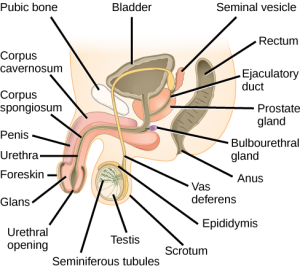15.12 Inspection and Palpation of the Male Genitalia
Inspecting the external male genitalia involves the following steps:
1. Before inspecting the genitalia, assess for the presence of anxiety.
- Examination of the male genitalia can create feelings of discomfort and nervousness in clients, so you should always employ a trauma-informed approach.
- Explain each step.
- Ask permission to touch.
- Use a drape, and only expose the client as long as needed.
- Avoid words that may be triggering, such as “bed” and “spread your legs.” Instead, use “exam table” and make requests like “move this leg out.”
- Ask the client if they would like to have another person present such as a family member/friend or another health care provider.
2. Inspection of the male genitalia (see Figure 15.11) includes the penis, urethral meatus, scrotum, scrotal contents, and testicles.
- Inspect for hair distribution.
- Inspect the penis; identify if it is circumcised or not circumcised. If uncircumcised, the examiner must retract the foreskin/prepuce to reveal the glans of the penis.
- Inspect the glans including urethral meatus for color; note discharge, redness, discoloration, or lesions.
- Inspect the shaft of the penis for color, shape, tone, redness, rash, prominent vasculature, or lesions.
- Inspect the scrotum in a standing position and note symmetry, masses, undescended testes, hernia, edema, or lesions.

Palpating the external male genitalia
- Palpate the penile shaft, noting tone or masses.
- Palpate the scrotal sac, noting the presence of a testis on each side. If undescended testicle (cryptorchidism) is identified, palpate along the inguinal or abdominal region. Palpate each testis, noting any masses or irregularities (masses in scrotal sac should be trans-illuminated with a small strong light source).
- Palpation of the spermatic cord and vas deferens is an advanced skill.
Priorities of Care
Priapism is a medical emergency that occurs when a penis has a prolonged erection without sexual stimulation. It can be full or partial, and can last for hours. Priapism happens when blood becomes trapped in the penis and can’t flow out. If left untreated, priapism can cause permanent damage to the penis, including erectile dysfunction. The sooner priapism is treated, the lower the risk of damage

